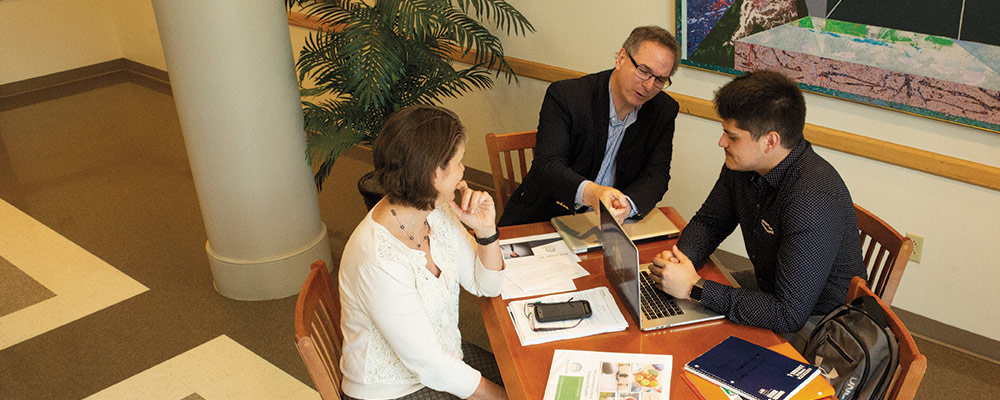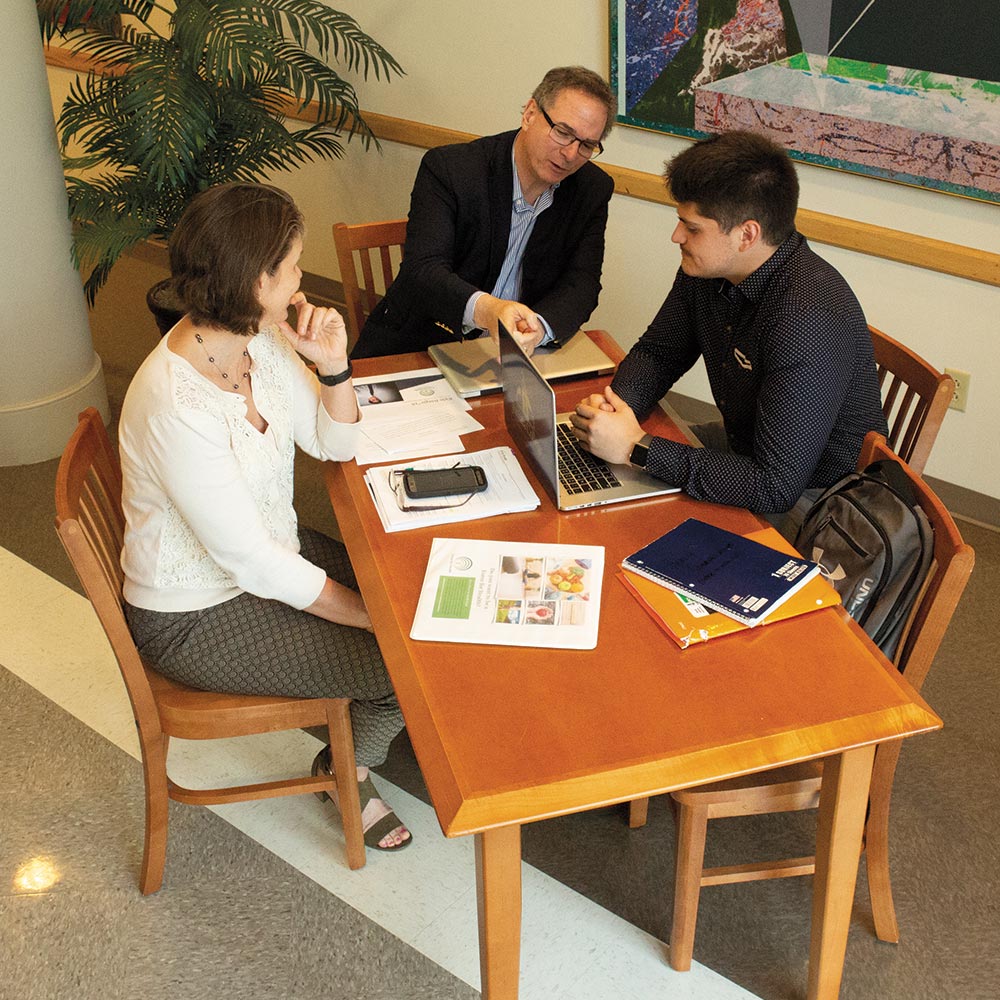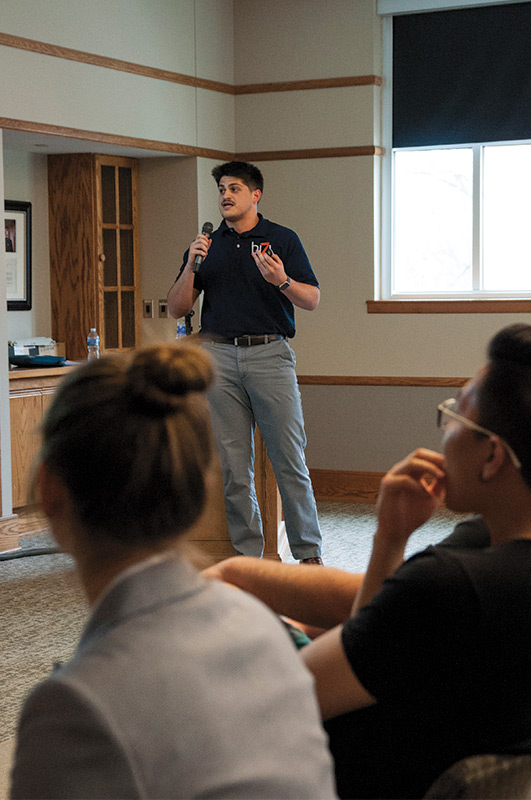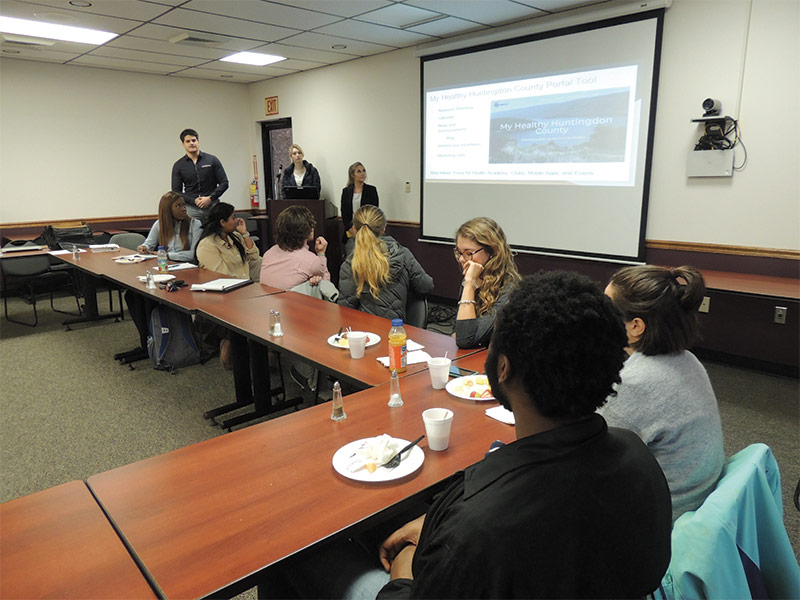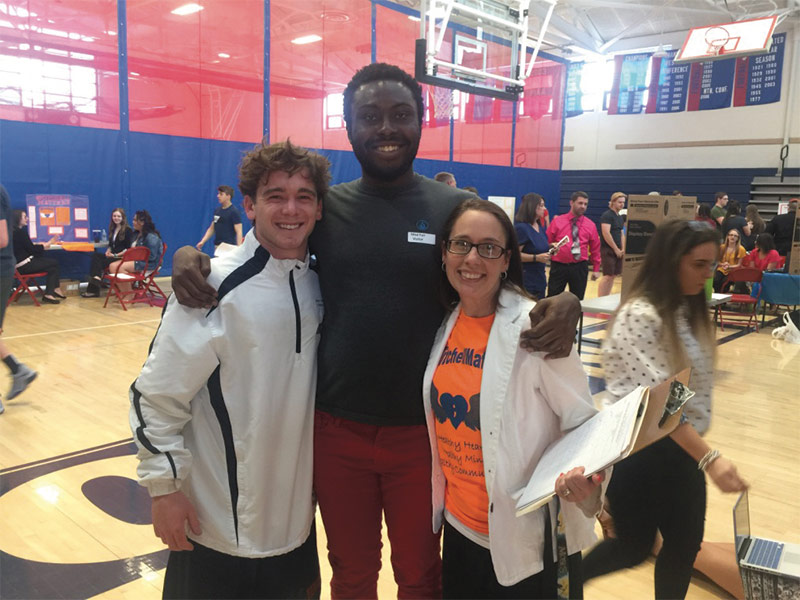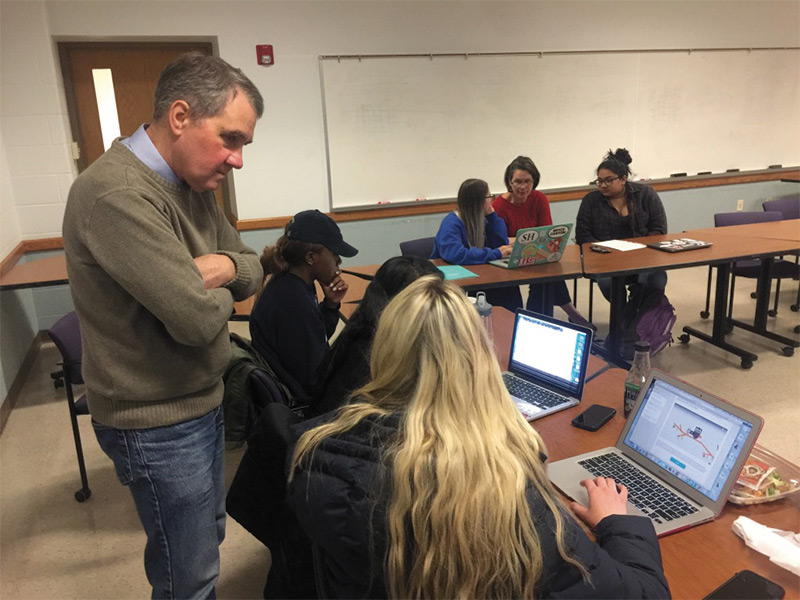But, by the end of the 45-minute presentation on health resources in Huntingdon, provided by seven of the 14 Juniata students in attendance, the room buzzed with chatter. Adam Dimm, chief executive officer of J.C. Blair Health System, Inc., announced: “You’ve laid the foundation for the next 50 years.”
“I’d be proud to take these students anywhere.”Dr. Robert Gillio, pulmonologist, J.C. Blair Health System, Inc.
Dr. Lauren Hughes, Pennsylvania’s Deputy Secretary for Health Innovation, also praised the students’ work. One of their instructors for the health communication practicum, Dr. Robert Gillio, a pulmonologist who serves as medical director for population health and clinical innovation with the health system, said, “I’d be proud to take these students anywhere.”
The students’ presentation inspired accolades not simply because of the deceptively simple idea they explained. Students described work underway to make wellness more readily attainable for people in Huntingdon County and provided an insight into potential gains for rural health. Their work had influenced several community initiatives and their understanding of challenges and creativity provided a window into what is possible.
For the last few years, Juniata has increased the ways students can learn through engaged community action. “Engaged” is key; this is not simply volunteering for an afternoon to clean cages at a pet shelter or gather trash from a riverbank.
“Community-engaged learning” prioritizes substantial connections between the experiences and students’ academic work. Such learning requires students not only to lean on what they know but to use their knowledge in unexpected ways. Their faculty prioritize some element of reflection. Do students write about how their learning is affected? Do they consider challenges in what they learn and how it can be applied? Do they encounter the difficulties of uncertain environments and learn how to prevail? What do they learn about genuine collaboration with community partners?
The Juniata students presenting that morning were enrolled in a health communications course, a partnership between the College and Gillio, who brought to Huntingdon the Force for Health (FFH) program.
“Hearing their concerns and perceptions, I realized how engaging people and tying it back to the community could make a difference. We would build a thing people would use.”Kyle Bargo ’18, information technology, Reedsville, Pa.
FFH is a nonprofit focused on empowering people and organizations to influence healthy decision making. The organization believes empowered groups can improve the social determinants of health. Those determinants include access to healthcare, knowledge of wellness behaviors, discrimination, and living environments across the community, to name a few. FFH partners with companies, communities, and people to share resources and collaborate to advance a culture of wellness.
FFH started in Louisiana after Hurricane Katrina, when volunteers helped rebuild health education resources and healthcare in the community. Led by teenagers and young adults who took charge of helping their families and peers make healthy decisions, the program showed the power of social organization to motivate communities to embrace healthier behaviors.
Given FFH’s aim to engage the community—grade school students, community organizations, religious organizations, civic groups, and others—it made perfect sense to align with a health communications course at Juniata.
Added as a designated Program of Emphasis (POE) at Juniata in 2011, health communication has attracted student interest steadily since, particularly as issues in population health have demanded more people skilled in communication. Given the College’s strengths in health care preparation and medical research, the health communications POE complements established strengths.
Gillio and Christine Gildea, director of marketing and public relations for J.C. Blair Memorial Hospital, sought community partners to activate FFH programming in the area. Gillio and Gildea approached Juniata in fall 2017 about the possibility for the class. After President James Troha and Provost Lauren Bowen green-lighted the venture, the class was offered for spring 2018. Fourteen students enrolled.
Kyle Bargo ’18 of Reedsville, Pennsylvania, took the class to prepare for a job he had in-hand. An information technology POE who has also declared a secondary emphasis in marketing and management and played as a defensive lineman for the Eagles, Bargo had taken an internship with UPMC during the summer before his senior year. The internship was competitive; successful candidates could interview for a position with the company at the end of the summer and Bargo prevailed.
With a job waiting for him in the healthcare industry, Bargo thought it would be a good idea to gain additional experience.
The class broke into three teams. The portal team created a website with health, prevention, and wellness resources. The academy team produced and edited educational content for the portal. The clubs team helped empower organizations to be forces for health throughout the county. For all of this, they had 15 weeks. Bargo’s role was to create the online platform and app through which people would access resources.
After the first class and having learned the extent of the project, facing the last semester of his senior year and a variety of commitments, Bargo nearly dropped the course. But then he attended a town hall in January with his classmates. People from around the county gathered at the hospital.
“Hearing their concerns and perceptions, I realized how engaging people and tying it back to the community could make a difference,” Bargo says. “We would build a thing people would use.”
“I didn’t expect the reaction from people that the project got, or how well it ended up coming together. Every week felt like we were shooting from the hip. We had to learn to roll with it.”Aisha Nelson ’18, public health communication, Brooklyn, N.Y.
Aisha Nelson ’18, a public health communication POE from Brooklyn, New York, recalls the same public meeting. “Until that moment, I thought I wanted to work in health care administration,” she says. “That moment changed my mind.”
Now, she wants to have a more direct impact.
Nelson worked on the academy team, producing 10 course modules with videos. Videos covered subjects from diabetes to prenatal care to opioid addiction. In the end, the team made more than 30 videos for the project.
Each of the three teams cooperated with different community organizations. The clubs team partnered with a teacher at Huntingdon Area High School to help students develop clubs focused on wellness.
During the semester, a tragedy hit the high school when a local student took his own life. Understandably, high school students wanted to focus their FFH club on mental wellness and bullying prevention rather than their original topic. The team adjusted.
The academy team also worked with the South Central Pennsylvania Tobacco-Free Coalition to develop educational content, but again had to be flexible and adapt to changing client timelines.
As the team completed modules, and the projects coalesced, clients expressed enthusiasm for the work. The group heard results. Gildea and Gillio shared news of their impact.
“I didn’t expect the reaction from people that the project got, or how well it ended up coming together,” Nelson says. “Every week felt like we were shooting from the hip. We had to learn to roll with it.”
Axel Jessin ’18, a managerial health sciences POE from Austin, Texas, was connected to the class due to his internship with the FFH Foundation board, serving as administrative director for interns. Charged with handling some of the administrative, accounting, and legal duties necessary to establish an FFH organization in Huntingdon, he gained valuable insight about mobilizing volunteers.
Another benefit, for him, was more surprising.
“It was the first time I strongly associated with the Huntingdon community,” he says. “Other things I’ve seen had died out, or they were limited. This effort has a much greater understanding of the challenges and opportunities in this area.”
Jessin helped organize community meetings that attracted more than 800 people over the course of the year. Like Bargo, he learned from hearing people’s stories, realizing how mobilizing others can be so effective. Given his academic work in examining health management and health care issues, he found the community engagement illuminating.
“A lot of health care nonprofits usually throw money around to figure out the size of problems,” he says. “We heard people crying, who had lost young people to opioids, or who knew people who had gone bankrupt. We know there are problems. We can figure out how big they are, but we also have to help people to do something now. This work helps do that.”
“We heard people crying, who had lost young people to opioids, or who knew people who had gone bankrupt. We know there are problems. We can figure out how big they are, but we also have to help people to do something now. This work helps do that.”Axel Jessin ’18, managerial health sciences, Austin, Texas
Faculty at the College and administrators at the hospital are excited with how the class worked. The students’ presentations that morning showed the potential of organized involvement. Their answers to questions revealed how much they learned in the semester about the pace and unpredictability of public engagement while illuminating the thorny complexities of health issues.
Sarah Worley ’00, associate professor of communication and director of community-engaged learning at Juniata, describes the class as exactly the sort of transformational experience the College wants to create for students. Even better, she notes, “this is something that has the power for real change in the community, so that the College lives its values and its mission.”
